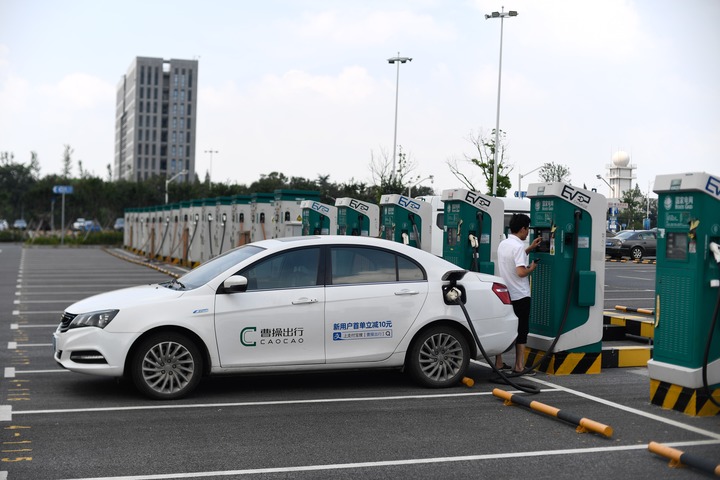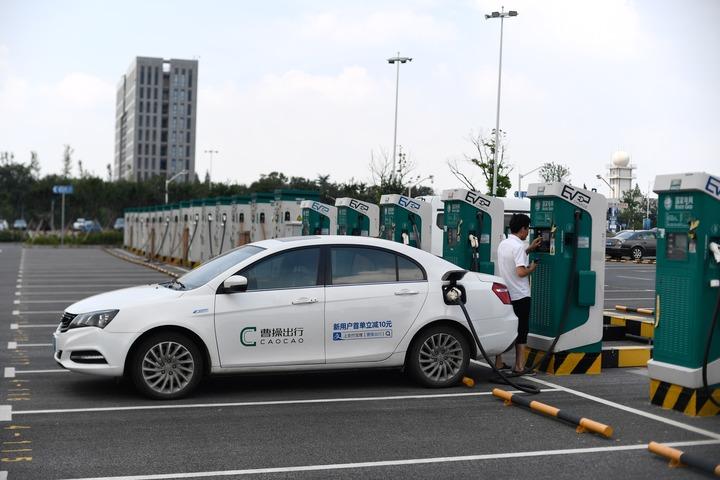
A driver charges his car at the parking lot of Hangzhou Xiaoshan International Airport in east China's Zhejiang Province, Sept. 1, 2020. (Xinhua/Huang Zongzhi)
BEIJING, May 19 (Xinhua) -- China's New Energy Vehicle (NEV) market in 2021 saw explosive growth despite subsidies for the NEV have been dropped off. Experts said that while the government cut some supportive industrial policies, China's NEV industry showed stronger market confidence with a consensus on the market, paths and polices.
Take a broad view in the global NEV market, European auto companies' benchmark status has been shaken as they lack industrial chains due to the marginalization of the battery and electronics industries.
Caused by the COVID-19 pandemic, uncertain factors such as chip shortage and rising prices of raw materials have impacted the stability of the supply chain in the NEV sector. Still, industry insiders hold that the Chinese NEV industry has built consensus in the transformation process, and the Chinese auto industry may embrace more new opportunities in the NEV field.
-- Dilemmas and prospects of battery-swapping model
On May 10, the municipality of Chongqing in southwest China unveiled a pilot plan on the application of NEV battery swapping, setting a goal of building more than 200 battery swap stations in the city by 2023 and promoting at least 10,000 battery-swappable NEVs.
On February 24 this year, the Shanghai Municipal People's Government issued the Implementation Opinions on further promoting the construction of charging and battery swap infrastructure, proposing that by 2025, Shanghai's NEV charging and battery swap stations will meet the demand of more than 1.25 million NEVs.
On March 31, east China's Jiangsu Province issued measures for the administration of the construction and operation of NEV charging and battery swap facilities, the first of its kind at the provincial level in China.
Meanwhile, the province took the lead in passing the review of the group standard of technical specifications for pure electric heavy trucks' swappable battery pack system on April 23 this year, which may become the first such standard in China.
At present, the NEV battery swapping industry is concentrated in Beijing and coastal regions such as Shanghai and Zhejiang Province, where supportive policies are more refined and standardized.
China's local governments have gradually encouraged the development of the NEV battery-swapping model, which is inseparable from the guidance of national policies and the practice of enterprises.
-- Coordinated development of Battery-swapping model
As early as 2020, the battery-swapping model in China's NEV industry has embraced a period featuring policy bonuses. China's auto maker giants such as Aulton New Energy, BAIC BLUEPARK, NIO and other major carmakers accelerated the expansion of battery swap stations.
The transition from battering charging to battery swapping dates back to 2020, when the electric vehicle (EV) standards subcommittee of the National Technical Committee of Auto Standardization held a review meeting in Shenzhen, south China's Guangdong Province.
During the meeting, China's leading NEV maker including BAIC New Energy, NIO, and China Automotive Technology and Research Center Co., Ltd (CATARC), among others, jointly led the drafting of safety requirements for NEV Battery Swapping at the meeting, thus providing guidance for the sound development of the battery-swapping NEV industry.
In 2021, the battery-swapping model gained increasing support from national policies. For example, China proposed to step up the construction of new infrastructure for battery swapping, and battery swap stations, referred to as "new infrastructure construction".
At the same time, the Ministry of Industry and Information Technology (MIIT) and the National Energy Administration (NEA) also jointly launched pilot projects to promote the innovative application of the NEV battery-swapping model.
In January this year, the National Development and Reform Commission (NDRC), the NEA and other departments jointly issued the opinions on further improving the service and support capacity of NEV charging infrastructure, proposing to standardize battery swapping and enhance the safety and reliability of related products.
The opinions also clarify the construction of specific battery swap stations for heavy trucks, rentals, and logistics, and the development of the "vehicle/battery separation" battery swapping model.
Xin Guobin, vice Minister of the MIIT told at a press conference of the State Council Information Office earlier this year, that relevant technical standards and administrative policies will be further improved, and companies will be encouraged to develop battery-swappable models in China.
As the lead drafters of the safety requirements for NEV Battery Swapping, BAIC BLUEPARK and NIO have been making continuous efforts in the field of battery swapping as early as 2020.
At that time, BAIC BLUEPARK had been exploring for battery swapping for up to ten years, becoming the first company to advance large-scale commercialization of battery swapping in China. BAIC BLUEPARK has built 187 battery-swap stations in 19 cities across China, and put up to 18,000 battery-swappable vehicles into operation, and registering a total of 4.8 million battery swaps.
It is noted that NIO has also built 131 battery swap stations across China, with the maximum number of battery swaps for a single vehicle reaching 301 times. The first owners of NIO ES6 and ES8 models are even entitled to free lifetime battery swap services, without restrictions on mileage, number of times, or the choice of battery swap stations.
On January 18 this year, Contemporary Amperex Energy Service Technology Ltd. (CAES), a wholly-owned subsidiary of Contemporary Amperex Technology Co. Limited (CATL) officially launched its EVOGO brand, which provides overall battery swap services for consumers.
According to its plan, the first batch of EVOGO battery swap services will be launched in ten cities across China. Given that CATL holds 32.6 percent of the global EV battery market, its launch of such services marks that the battery-swapping model will gradually scale new levels in the national market.
Some industry analysts said that afore mentioned plan released by Chongqing may be related to the official settlement of Chongqing Ruilan Auto Technology Co., Ltd. in Liangjiang New District of Chongqing a few months ago, and the opening of investment promotion at the same time. The company, founded by Geely Auto and Lifan Technology, is a carmaker with independent production qualifications.
The battery-swapping model is thus entering a period of rapid development with promising prospects.
-- New prospects and dilemmas of battery-swapping model
According to Minsheng Securities, China had a total of 1,298 battery swap stations in 2021, slightly up from 2020. With battery giants entering the battery-swapping sector, such commercial is expected to usher in new opportunities.
According to Soochow Securities, 2022 kicks off the peak years of battery swap stations in China, with relevant device manufacturers being benefited. The core equipment of battery swap stations is those for charging, discharging, testing and automation.
It is estimated that the year 2025 alone China will see another 16,000 battery swap stations and an additional 60 billion-plus yuan in equipment investment. AVIC Securities is even more optimistic, predicting that China will have more than 20,000 battery swap stations in 2025.
In addition, the battery-swapping model features a short time of energy replenishment, low cost of car purchase, and timely elimination of battery safety hazards. These advantages make industry insiders optimistic about the model's prospects, with some experts predicting that the total market space for the operation of battery swapping in 2025 will reach 60.5 billion yuan.
While the battery-swapping model is developing rapidly, there are still deficiencies in the construction of EV charging infrastructure.
According to the Analysis Report on Market Prospects and Investment Strategic Planning of China's EV Battery Swap Industry (2022 to 2028) by Zhiyanzhan Industry Research Institute, the deficiencies in the construction of EV charging infrastructure mainly include, difficulties in power transformation restrict to build charging piles in some residential communities, and it is also difficult and time-consuming for users to find charging points accurately.
At the same time, some charging points lack timely operation and maintenance, as well as contingency plans for charging. Additionally, the construction of EV charging infrastructure is still plagued by the unbalanced development of public charging facilities and the uneven distribution of public charging stations in cities.
Data shows that at present, there are 810,000 public charging points in China, more than 70 percent of them in Guangdong Province and Shanghai. Most of the 13,800 charging points on expressways in China are installed in Beijing, Tianjin, Hebei, and Shandong, Yangtze River Delta, and Pearl River Delta, while less developed areas are expected to be fully covered in the future.
Time and hard work are necessary for governments and enterprises to cope with so many difficulties. With more capital investment, China's charging pile industry is expected to usher in broader development prospects, according to Tong Zongqi, an expert with the China Electric Vehicle Charging Infrastructure Promotion Alliance. (Edited by Jiang Feifan with Xinhua Silk Road, 346129473@qq.com)




 A single purchase
A single purchase









